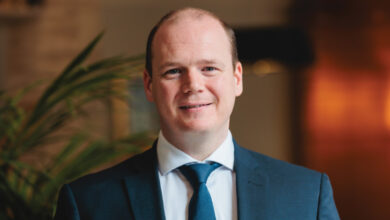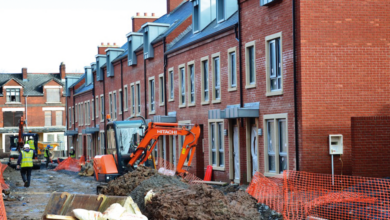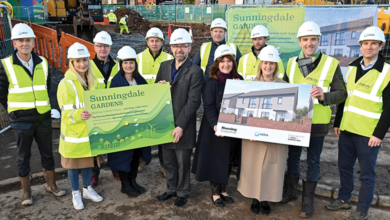Building for the future

New Housing Executive Chief Executive Grainia Long discusses the role of the organisation in planned transformation of the housing sector and how the ability to borrow will have positive outcomes for exiting and future tenants.
Long, a housing professional for over 20 years, officially took up post in April 2021 and quickly set to work getting to grips with an organisation she knows is at its best when focused on people.
As someone who has previously worked in partnership with the Housing Executive, Long is well aware that decisions taken by the largest public sector landlord in western Europe, and owner of some 85,000 homes, are massively impactful on a range of individuals and so must be made with “empathy, sincerity and professionalism”.
“My vision for the organisation is one that is very people-centred,” she explains. “Everything we do should be done for positive outcomes for the communities that we serve and the people in our homes. That 70,000 children and young people go to sleep in Housing Executive homes every night highlights the responsibilities that we have.
“What has really pleased me is that there is a strong, existing understanding of that responsibility. Culturally, as an organisation, we know we are there, primarily, to keep people safe, warm and dry in their homes.”
The importance of this understanding has never been more evident than in the context of the transformative events of the past year. As well as dealing with the wide-ranging impacts of the pandemic, in November, the organisation learned of the Housing Minister’s vision for transformation of the housing sector and, in particular, revitalisation of the Housing Executive.
Long takes little credit for the agility shown by the Housing Executive in response to the pandemic, something that was already well underway by the time she joined but describes the impacts of the move to ensure staff safety and redesign services as both “profound” and “long-lasting”.
The Chief Executive says that as a services-orientated organisation, the primary focus was on ensuring connection with tenants and wider communities was not undermined. Although assessing the organisation’s response as largely successful, Long recognises an opportunity to learn from the pandemic response for future improvement.
“The first step we must take is to fully assess the impact of this year on our staff, our systems and our services, and any long-term impact. Where we see issues we can act quickly, such as investing in the health and wellbeing of our staff. However, we also have to identify what improvements and innovations have been made and ensure that we retain them going forward,” explains Long.
Revitalisation
Embedding those improvements will be a critical part of the future of the organisation. The year 2021 marks 50 years since the organisation’s formation, introduced as a strategic housing authority to bring equality and fairness to the allocation of housing in Northern Ireland. Since then, the organisation has evolved.
Housing benefit administration of some £600 million, responsibility for assisting the homeless in Northern Ireland, tackling anti-social behaviour and promoting social enterprise are examples of services delivered by the Housing Executive beyond its original remit, as it sought and succeeded to deliver for changing demands.
Long is well aware that she has taken up post at a critical juncture of the Housing Executive’s future, with the groundwork being laid to how the next 50 years of the organisation might look. Central to that vision are ministerial plans to reform Northern Ireland’s housing system and revitalise the Housing Executive.
The Chief Executive welcomes the ambition of the Minister’s vision, identifying intractable problems in housing supply and identifying the need for transformative measures.
“Revitalisation of this organisation and the ability to borrow is critical to our ambitions to reinvest in our stock and decrease the gap between the level of social housing supply and those waiting for homes.”
While the scale of reform is wide-ranging, one of the most significant ambitions is to equip the Housing Executive with the power to borrow.
“What is really exciting about the ministerial statement is that it sets out a plan to enable this organisation to have the freedom and autonomy to do things it can’t currently do,” says Long.
For the past two decades, housing demand in Northern Ireland has outstripped supply. As a result, Northern Ireland faces a social housing shortage, and some 40,000 people are currently on the social housing waiting list.
Much emphasis has been put on how the Housing Executive’s ability to build again will help reduce the gap between supply and demand, however, Long emphasises the importance of borrowing power also enabling greater investment in existing stock.
“Our ability to set out what our borrowing is for is very important,” she states. “Any landlord with the capacity to borrow will use that capacity, not just to build, but to invest in their existing stock and to maintain the quality and standards of their homes.
“It is really important that we treat with equal importance our future tenants and our existing tenants.”
Long is complimentary of the role housing associations have played as social housing providers, particularly over the previous years. Figures from the Department for Communities show that in 2020/21, 2,403 new social homes were started, 30 per cent more than the target. However, she recognises a long-term “structural inability” to close the social housing supply and demand gap.
“We have seen that incrementalism is not closing the gap at a quick enough pace and so we need to try new methods. One of those methods is enabling this organisation to borrow and to build. We plan to do that alongside our delivery partners and alongside housing associations who have proven their ability to build at scale and to invest in communities.
“Output for the previous year was really positive and is evidence that we have an eco-system of housing deliverers who work well together. It is in everyone’s interest that we continue with that, but we also need to increase the numbers and that is why revitalisation is so exciting,” states Long.
The Chief Executive does not have a preferred model for the future of the organisation. Instead, she says, attempts to pursue a specific model at this stage would “miss the opportunity” to sufficiently focus on the organisation’s mission and purpose for the future.
“Tenants have to be at the core of this,” stresses Long. “If we spend too much time focused on the legal structures now then I think we will miss the opportunity to engage with current and future tenants on their strategic interests.”
“If we spend too much time focused on the legal structures now then I think we will miss the opportunity to engage with current and future tenants on their strategic interests.”
The Housing Executive is currently working with the Department for Communities to deliver a business case by March 2022, which is set to include a range of options on how borrowing may be raised and an outline of what that borrowing will then be spent on.
“Previous attempts to think differently about this organisation and restructure the organisation have, in my view, felt like they were being done to the Housing Executive. One of the first questions I asked on entering the Housing Executive was whether this was being done with or to the organisation. I think it is very important that we are working alongside the Department to deliver a transformational process.”
Another reason this collaboration is important, explains Long, is that even with the capacity to build, the Housing Executive will still face many of the challenges currently being felt by social housing providers including issues like land availability and the speed at which planning decisions are taken.
“We need to look in strategic terms, not just as organisations, but as a housing sector, at those challenges which have been limiting supply.”
Economic recovery
Long is quick to point out the wider benefits of housing sector transformation on Northern Ireland’s economy, something which is vitally important as the economy seeks to recover from the impact of the pandemic.
On the role of the Housing Executive, she says: “The sheer scale of the economic impact of this organisation can not be overstated. We plan to invest £217 million towards stock improvements this calendar year and that investment will not only be beneficial for tenants but will have a positive impact on jobs and supply chains, locally.
“There are very few organisations in Northern Ireland investing at that level in physical infrastructure, which we know has a large multiplier effect in relation to the economy.”
The Housing Executive’s maintenance programme over the next seven years spans to several hundred million pounds, included in which is at least 50 apprenticeship places annually. Long adds: “Market cycles come and go but housing has the potential to be a constant and sustainable growth lever. That places us as a key organisation economically.”
The Chief Executive is aware of her organisation’s central role in not just the economic but also the environmental future of Northern Ireland. The region is set to target net-zero carbon by 2050. While progress has been made in relation to electricity decarbonisation, little progress has been made in relation to heat, transport and agriculture.
“We will not get to net-zero emissions without transformation of the housing system and without retrofitting the existing stock across housing,” states Long. “Central to that is our 85,000 existing homes and any new ones that we build. We understand our responsibility and it is one that we take on with relish.
“On joining the organisation, I found teams of people with expertise and focus on the transition to net-zero carbon who were already well advanced in their thinking and that puts us in a really good place.”
One practical example of the positive impact of this work offered by Long is matched funding by the Housing Executive of the European Regional Development Fund, which will see €38 million in total spent on energy efficiency upgrades of some 2,000 homes.
“We’re central to the decarbonisation agenda and conscious of the forthcoming Energy Strategy from the Department for the Economy and we’re working alongside officials in relation to energy efficiency. We’re also engaged with the Department of Agriculture, Environment and Rural Affairs on the Green Growth Strategy. These aspirations will be challenging but I’m excited about our role because of the scale of the potential benefits.”
Homelessness
An increase in supply and reinvestment in stock will also go some way to helping address Northern Ireland’s growing homelessness problem. The Housing Executive is legally responsible for helping those who are homeless and preventing homelessness in Northern Ireland. In 2019, almost 20,000 people and families asked the Housing Executive for help dealing with homelessness.
Recently, the Housing Executive launched their Homelessness Reset Plan, a response to the impacts of Covid-19 on homelessness. Outlining, the reasoning behind the plan, Long says: “The actions taken since early March 2020 have mirrored much of our existing strategic commitments, but the pandemic has forced faster progress on key fronts.
“We need to protect this progress while also considering the wider strategic impacts.”
In May the Minister confirmed that she would fully fund the £9 million investment of the Housing Executive’s Reset Plan for this year.
The response from the Housing Executive, the community and voluntary sector and the private sector to rough sleeping at the outbreak of the pandemic was highly commended but also recognised as an emergency response to a crisis situation.
“I don’t think anyone around the table would say that what we came up with was a sustainable solution, because what we were doing was placing people in accommodation that was temporary,” says Long, who explains that the plan also goes beyond rough sleeping and to those individuals and families in unsuitable accommodation.
“Any landlord with the capacity to borrow will use that capacity, not just to build, but to invest in their existing stock and to maintain the quality and standards of their homes.”
Highlighting a recognition that the profile of homelessness has changed over recent years and that many of the complex underlying issues often identified in relation to homelessness are set to be compounded by the pandemic, the Chief Executive hopes that the collaboration which saw an effective response to the pandemic can now be carried over to deliver long-term solutions.
“The solutions that were delivered were only ever designed to be temporary, so, the next set of challenges are different, and the solutions will need to be different. The Reset Plan is about recognising this and about deliberately doing things differently than was the case during the pandemic but retaining the collaboration and problem-solving in the same focused way.”
The approach to the Reset Plan will also largely inform the Housing Executive’s future Homelessness Strategy, which is currently in development to be delivered for 2022. Long adds: “Now is the perfect time to step back and assess where we have succeeded in the past two decades and what are the learnings we can take from the things that haven’t worked.
“We are a strategy-heavy organisation and sector and while strategies are important, the critical factor is in delivery. Our strategy will be delivery-focused because homeless people deserve a delivery-focused plan.”
Concluding with her short, medium, and long-term goals of her tenure, the Chief Executive says that the immediate focus must be on recovery from Covid. Further out, she believes the impact of investment in existing stock will be felt by residents through planned maintenance in the coming years, with a multiplier effect on the local economy.
Finally, she says: “This organisation has capacity to do so much more than it is doing. I look forward to releasing and realising that capacity with a focus on social outcomes in the years ahead. Revitalisation of this organisation and the ability to borrow is critical to our ambitions to reinvest in our stock and decrease the gap between the level of social housing supply and those waiting for homes.”
Profile: Grainia Long
Grainia took up post as the Chief Executive of the Housing Executive in April 2021. Prior to this she was the Commissioner for Resilience for the city of Belfast and co-Chaired the Belfast Climate Commission. Grainia was also the Chief Executive of the national child protection charity in the Republic of Ireland, ISPCC Childline. This position followed several years working in housing, including as Chief Executive of the Chartered Institute of Housing (CIH), and previously national Director of the CIH in Northern Ireland. She has served two terms as a member of the Northern Ireland Human Rights Commission, was a member of the Lyons Commission on Housing Supply and Advisor to the Best Commission on the Future of Housing in Northern Ireland. She is a Senior Independent Director on the Metropolitan Thames Valley Housing Group Board, a social housing provider in England.
Grainia is Dublin-born but came to Belfast to study at Queen’s University Belfast, and she has returned to the city following several years in Scotland and England. Her weekends are kept busy with her husband, a three-year-old child and 12-year-old dog, which she says often involves outdoor activities, including long walks. Over the pandemic, she has rediscovered a love for home cooking, on which, she admits, the jury remains out.







